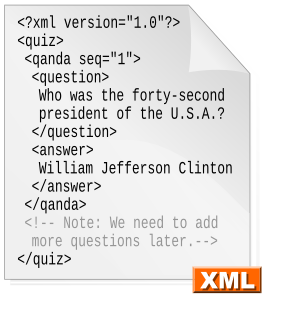LaTeX is a document preparation system. When writing, the writer uses plain text as opposed to the formatted text found in WYSIWYG word processors like Microsoft Word, LibreOffice Writer and Apple Pages. The writer uses markup tagging conventions to define the general structure of a document, to stylise text throughout a document, and to add citations and cross-references. A TeX distribution such as TeX Live or MikTeX is used to produce an output file suitable for printing or digital distribution. Within the typesetting system, its name is stylised as LaTeX.

In computer text processing, a markup language is a system for annotating a document in a way that is syntactically distinguishable from the text. The idea and terminology evolved from the "marking up" of paper manuscripts, i.e., the revision instructions by editors, traditionally written with a red or blue pencil on authors' manuscripts. In digital media this "blue pencil instruction text" was replaced by tags, which indicate what the parts of the document are, rather than details of how they might be shown on some display. This lets authors avoid formatting every instance of the same kind of thing redundantly. It also avoids the specification of fonts and dimensions, which may not apply to many users.

A text editor is a type of computer program that edits plain text. Such programs are sometimes known as "notepad" software, following the naming of Microsoft Notepad. Text editors are provided with operating systems and software development packages, and can be used to change files such as configuration files, documentation files and programming language source code.
DocBook is a semantic markup language for technical documentation. It was originally intended for writing technical documents related to computer hardware and software but it can be used for any other sort of documentation.
In typography, a bullet is a typographical symbol or glyph used to introduce items in a list. For example:
In computing, the diff utility is a data comparison tool that calculates and displays the differences between two files. Unlike edit distance notions used for other purposes, diff is line-oriented rather than character-oriented, but it is like Levenshtein distance in that it tries to determine the smallest set of deletions and insertions to create one file from the other. The diff command displays the changes made in a standard format, such that both humans and machines can understand the changes and apply them: given one file and the changes, the other file can be created.
Doxygen is a documentation generator, a tool for writing software reference documentation. The documentation is written within code, and is thus relatively easy to keep up to date. Doxygen can cross reference documentation and code, so that the reader of a document can easily refer to the actual code.
reStructuredText is a file format for textual data used primarily in the Python programming language community for technical documentation.
Plain Old Documentation (pod) is a lightweight markup language used to document the Perl programming language.
Javadoc is a documentation generator created by Sun Microsystems for the Java language for generating API documentation in HTML format from Java source code. The HTML format is used for adding the convenience of being able to hyperlink related documents together.
The following tables compare general and technical information for a number of documentation generators. Please see the individual products' articles for further information. Unless otherwise specified in footnotes, comparisons are based on the stable versions without any add-ons, extensions or external programs.
PHPDoc is an adaptation of Javadoc for the PHP programming language. It is still an informal standard for commenting PHP code, but it is in the process of being formalized. It allows external document generators like phpDocumentor, which is the de facto standard implementation, to generate documentation of APIs and helps some IDEs such as Zend Studio, NetBeans, JetBrains PhpStorm, ActiveState Komodo Edit and IDE, PHPEdit and Aptana Studio to interpret variable types and other ambiguities in the loosely typed language and to provide improved code completion, type hinting and debugging.
Textile is a lightweight markup language that uses a text formatting syntax to convert plain text into structured HTML markup. Textile is used for writing articles, forum posts, readme documentation, and any other type of written content published online.
Markdown is a lightweight markup language with plain text formatting syntax. Its design allows it to be converted to many output formats, but the original tool by the same name only supports HTML. Markdown is often used to format readme files, for writing messages in online discussion forums, and to create rich text using a plain text editor.
Sandcastle is a documentation generator from Microsoft. It automatically produces MSDN-style code documentation out of reflection information of .NET assemblies and XML documentation comments found in the source code of these assemblies. It can also be used to produce user documentation from Microsoft Assistance Markup Language (MAML) with the same look and feel as reference documentation.
AsciiDoc is a human-readable document format, semantically equivalent to DocBook XML, but using plain-text mark-up conventions. AsciiDoc documents can be created using any text editor and read “as-is”, or rendered to HTML or any other format supported by a DocBook tool-chain, i.e. PDF, TeX, Unix manpages, e-books, slide presentations, etc.
JSDoc is a markup language used to annotate JavaScript source code files. Using comments containing JSDoc, programmers can add documentation describing the application programming interface of the code they're creating. This is then processed, by various tools, to produce documentation in accessible formats like HTML and Rich Text Format. JSDoc is free software under the Apache License 2.0.





